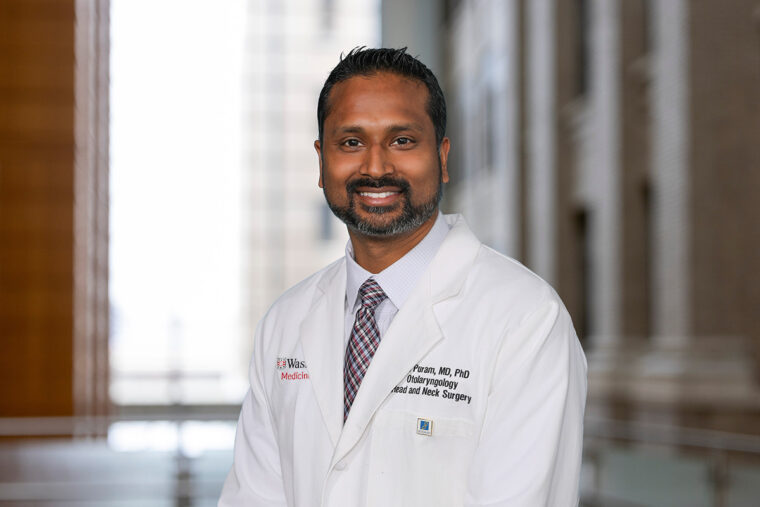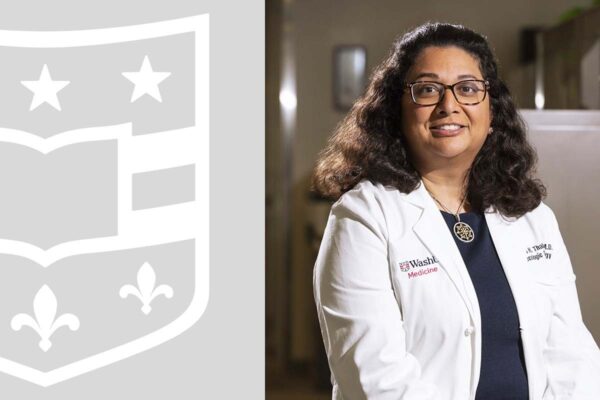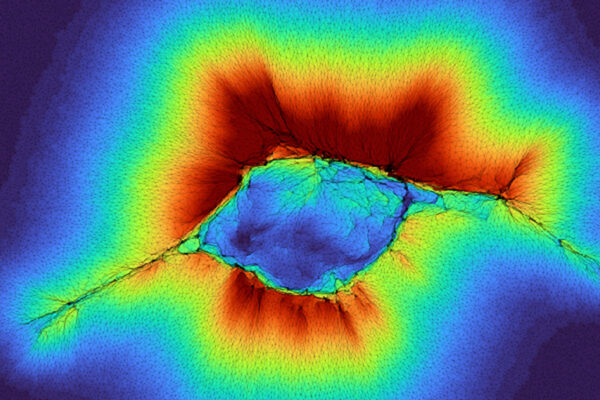Sidharth “Sid” V. Puram, MD, PhD, has been named the head of the Department of Otolaryngology — Head & Neck Surgery and the Lindburg Professor of Otolaryngology at Washington University School of Medicine in St. Louis. A nationally recognized physician-scientist specializing in head and neck cancer surgery, Puram currently serves as the Joseph B. Kimbrough Professor and director of the department’s Division of Head & Neck Surgery. He also is co-director of the Robert Ebert and Greg Stubblefield Head and Neck Tumor Center at Siteman Cancer Center, based at Barnes-Jewish Hospital and WashU Medicine. Puram’s new appointment begins Nov. 1.
His research has advanced understanding of tumor growth, treatment resistance and metastasis in head and neck cancers — discoveries that have opened new options for treating these challenging tumors.
“Dr. Puram is an exceptionally talented physician-scientist and mentor who was unanimously selected by our leadership team from an outstanding pool of candidates,” said David H. Perlmutter, MD, executive vice chancellor for medical affairs, the Spencer T. and Ann W. Olin Distinguished Professor and the George and Carol Bauer Dean of WashU Medicine, who announced Puram’s new appointment. “He will be leading a department that has always been esteemed but has grown in accomplishments and reputation in the last decade under the leadership of Dr. Craig Buchman. We believe Dr. Puram will inspire the otolaryngology team at WashU Medicine, with our partners at BJC HealthCare, to even greater impact and advance the science-based practice of care for patients with upper airways disorders in the coming decades.”
Puram’s research explores tumor heterogeneity — the complex ecosystem of diverse cells within a cancer and how they communicate with one another — a focus that has garnered significant funding from the National Institutes of Health (NIH). Understanding the cellular and genetic make-up of tumors can help scientists and clinicians identify and target the specific cells implicated in troubling behaviors seen in cancer such as tumor invasion, spread and resistance to therapy. His research has informed several innovative clinical trials and identified still other potential treatment avenues.
Detailing the diversity within tumors has pointed the way toward precision treatments for certain kinds of head and neck cancers and provides a foundation for developing therapies more tailored to the tumors of individual patients.
Through his leadership of the Division of Head & Neck Surgery at WashU Medicine, Puram has guided growth in both faculty and patient referrals while also establishing new collaborations with other departments to broaden the expertise offered to head and neck cancer patients with complex clinical needs. In his role as the inaugural co-director of the Robert Ebert and Greg Stubblefield Head and Neck Tumor Center, Puram has overseen a coordinated clinical program including head and neck specialists, oral health services, ancillary care and mental health care, among other services, with care coordination driven by patient navigation. This innovative, multidisciplinary approach is designed to improve patient outcomes by supporting patients throughout their cancer treatment while improving communication among the care team.
These programs reflect the department’s broader leadership in research and patient care. The department is the fifth-highest recipient of NIH research funding for otolaryngology departments. Each year, its physicians care for more than 120,000 patients and perform more than 11,000 surgeries, including nose and sinus operations; cochlear implants and other procedures to restore hearing; facial reconstruction surgeries; procedures to improve voice and swallowing; pediatric upper airway surgeries; and cancer surgeries.
“Otolaryngology at WashU Medicine is like no other in the U.S. in terms of its academic rigor and the collegiality of the faculty and researchers, so it is a great honor to have been selected to lead the department,” said Puram. “We have a fantastic team of physicians, researchers and trainees here who are absolutely committed to delivering the highest standard of care for our patients today and to carrying out rigorous research that will benefit the patients of tomorrow. Our team continues to push the boundaries through innovative surgical techniques and research projects that will disrupt traditional paradigms of care. I’m very excited to be able to carry that mission forward.”
As a head and neck cancer specialist, Puram is in the rare position as a physician of being both his patients’ surgeon and primary oncologist. With a particular focus on reconstructive surgery after the removal of head and neck cancer, he helps many patients return to their lives and minimize damage to key functions such as speech, swallowing, taste, hearing and smell.
Puram earned his bachelor’s degree from the Massachusetts Institute of Technology and earned both his MD and PhD from Harvard Medical School in 2013. For his graduate research, Puram identified signaling pathways in brain cells that affect the shape of their dendrites, which are key recipients of information.
Puram chose otolaryngology as his medical specialty because it provided him the opportunity to perform a variety of anatomically intricate and challenging surgeries while also practicing as a cancer specialist. He completed a residency in otolaryngology in the Massachusetts Eye and Ear Infirmary/Harvard Combined Program in 2018. During his simultaneous postdoctoral fellowship at Massachusetts General Hospital/MIT Broad Institute, Puram published the first single-cell atlas of head and neck cancers. He then completed his training with a clinical fellowship in microvascular reconstruction/head and neck surgical oncology at The Ohio State University Comprehensive Cancer Center – James before coming to WashU Medicine in 2019.
Puram serves on the National Institute of Dental and Craniofacial Research special grants review study section. He is also on the editorial boards of Surgical Oncology Insight, Head & Neck and Frontiers in Oncology. Puram has been recognized by his peers for his teaching, science and clinical skills. He received the American Society for Clinical Investigation Young Physician Scientist Award in 2020 and was named a Fellow of the American College of Surgeons in 2021. He received the Department of Otolaryngology — Head & Neck Surgery Faculty Teaching Award earlier this year.
About WashU Medicine
WashU Medicine is a global leader in academic medicine, including biomedical research, patient care and educational programs with more than 3,000 faculty. Its National Institutes of Health (NIH) research funding portfolio is the second largest among U.S. medical schools and has grown 83% since 2016. Together with institutional investment, WashU Medicine commits well over $1 billion annually to basic and clinical research innovation and training. Its faculty practice is consistently among the top five in the country, with more than 2,000 faculty physicians practicing at 130 locations. WashU Medicine physicians exclusively staff Barnes-Jewish and St. Louis Children’s hospitals — the academic hospitals of BJC HealthCare — and Siteman Cancer Center, a partnership between BJC HealthCare and WashU Medicine and the only National Cancer Institute-designated comprehensive cancer center in Missouri. WashU Medicine physicians also treat patients at BJC’s community hospitals in our region. With a storied history in MD/PhD training, WashU Medicine recently dedicated $100 million to scholarships and curriculum renewal for its medical students, and is home to top-notch training programs in every medical subspecialty as well as physical therapy, occupational therapy, and audiology and communications sciences.
Originally published on the WashU Medicine website



